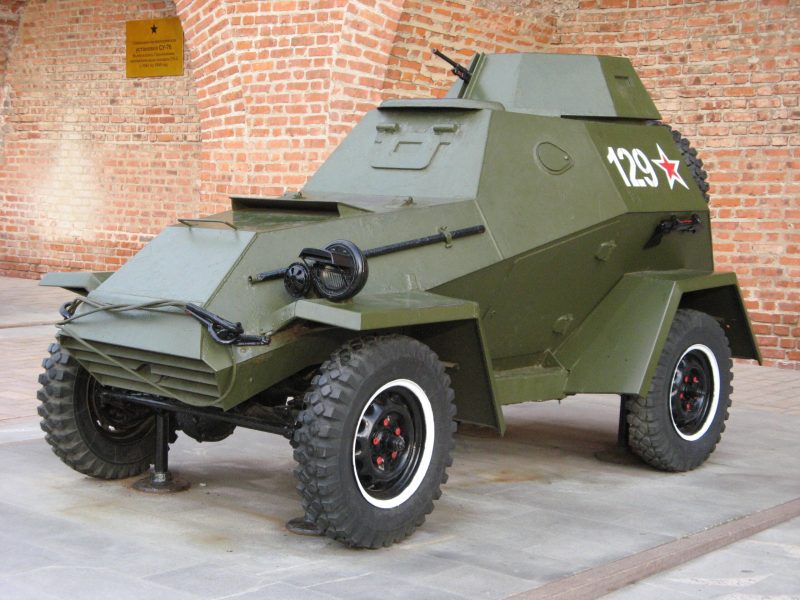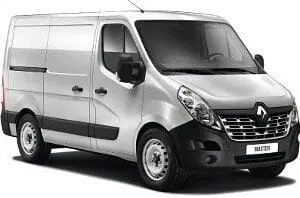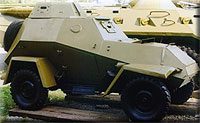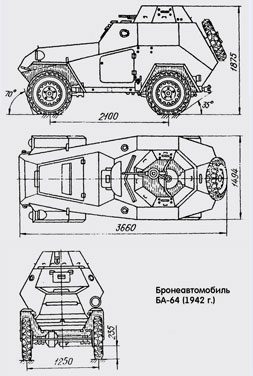
Light armored car BA-64
Content
Light armored car BA-64
The driver was located in front of the center of the car, and behind him there was a fighting compartment, above which an open-type tower with a DT machine gun was mounted. The installation of the machine gun made it possible to fire at anti-aircraft and air targets. To control the armored car, the driver could use a replaceable block of bulletproof glass, two of the same blocks were mounted on the side walls of the tower. Most of the cars were equipped with 12RP radio stations. At the end of 1942, the armored car was modernized, during which its track was expanded to 144b, and two shock absorbers were added to the front suspension. The upgraded BA-64B armored car was produced until 1946. In the course of production, its variants with a snowmobile and railway propellers, a variant with a large-caliber machine gun, an amphibious assault and a staff version were developed.
Taking into account the experience gained in the 30s of creating two-axle and three-axle chassis for armored vehicles, the Gorky residents decided to make a light machine-gun armored car for the active army based on the two-axle all-wheel drive vehicle GAZ-64. On July 17, 1941, design work began. The layout of the machine was carried out by engineer F.A.Lependin, G.M. Wasserman was appointed the leading designer. The projected armored car, both externally and in terms of combat capabilities, was sharply different from previous vehicles of this class. The designers had to take into account the new tactical and technical requirements for armored cars, which arose on the basis of an analysis of combat experience. The vehicles were to be used for reconnaissance, for command and control of troops during the battle. in the fight against airborne assault forces, for escorting convoys, as well as for air defense of tanks on the march. Also, the acquaintance of the factory workers with the German captured SdKfz 221 armored car, which was delivered to GAZ on September 7 for detailed study, also had a certain influence on the design of the new car. The design and manufacture of an armored car lasted about six months - from July 17, 1941 to January 9, 1942. On January 10, 1942, Marshal of the Soviet Union K. E. Voroshilov examined the new armored car. After the successful completion of factory and military tests, the armored car was presented to the members of the Politburo of the Central Committee of the All-Union Communist Party of Bolsheviks on March 3, 1942. and already in the summer of that year, the first batch of serial armored vehicles was sent to the troops of the Bryansk and Voronezh fronts. For the creation of the BA-64 armored car by the decision of the Council of People's Commissars of the USSR of April 10, 1942, V.A. Grachev was awarded the State Prize of the USSR.
Armored car The BA-64 was made according to the classical scheme with a front engine, front steered and all-wheel drive, with solid axles suspended in front on four quarter-elliptical springs, and at the rear - on two semi-elliptical springs. On top of a rigid standard frame from the GAZ-64, a multifaceted all-welded body was mounted, made of rolled steel sheets with a thickness of 4 mm to 15 mm. It was characterized by significant angles of inclination of armor plates to the horizontal plane, relatively small overall dimensions and weight. The sides of the hull consisted of two belts of armor plates of 9 mm thickness, which, to increase bullet resistance, were located so that the longitudinal and cross-sections of the hull were two trapezoids folded by the bases. To enter and exit the car, the crew had two doors that opened back and down, which were located in the lower parts of the sides to the right and left of the driver. An armored cover was hung in the rear end of the hull, which protected the filler neck of the gas tank. The BA-64 hull did not have riveted joints - the joints of the armor sheets were smooth and even. Hinges of doors and hatches - external, welded or on protruding rivets. Access to the engine was carried out through the upper armored cover of the engine compartment that opens back. All hatches, doors and covers were locked from the outside and from the inside. Subsequently, to improve the working conditions of the driver, air intakes were introduced on the top cover of the hood and in front of the cover of the armored hull. On the lower left side armor plate in front of the door (immediately behind the wing), a mechanical screw jack was attached with two clamps.
The driver of the armored vehicle was located in the control compartment in the center of the vehicle, and behind him, slightly higher, was the commander. acted as a machine gunner. The driver could observe the road and the terrain through a mirror observation device with a replaceable block of bulletproof glass of the “triplex” type, installed in the opening hatch of the front hull sheet and protected from the outside by an armored shutter. In addition, on some machines, side-view hatches were installed in the upper side sheets of the control compartment, which were opened if necessary by the driver. In the rear of the armored car on the roof of the hull, a circular rotation tower was installed, made by welding from armor plates 10 mm thick and having the shape of a truncated octagonal pyramid. In front of the junction of the tower with the hull was shielded by a protective overlay - parapet. From above, the tower was open and, on the first samples, was closed with a folding net. This provided the possibility of observing an air enemy and firing at him from airborne weapons. The tower was installed in the body of an armored car on a cone column. The rotation of the tower was carried out manually by the effort of the gunner commander, who could turn it and stop it in the required position using the brake. In the frontal wall of the tower there was a loophole for firing at ground targets, and two observation devices were mounted in its side walls, identical to the driver's observation device.
BA-64 was armed with a 7,62 mm DT machine gun. V armored car for the first time, a universal machine gun installation was used, which provided circular shelling from the turret of ground targets at a distance of up to 1000 m and air targets flying at an altitude of up to 500 m.The machine gun could move up the rack from the vertical embrasure of the turret and be fixed at any intermediate height. For firing at air targets, the machine gun was supplied with a ring sight. In the vertical plane, the machine gun was aimed at the target in the sector from -36 ° to + 54 °. The ammunition load of the armored car consisted of 1260 rounds of ammunition, loaded in 20 magazines, and 6 hand grenades. Most of the armored vehicles were equipped with RB-64 or 12-RP radio stations with a range of 8-12 km. The whip antenna was mounted vertically on the rear side (right) wall of the tower and protruded 0,85 m above its end. A slightly modified standard GAZ-64 engine was installed in the BA-64 engine compartment, capable of running on low-grade oils and gasoline, which was extremely important for the operation of an armored vehicle in front-line conditions. The four-cylinder liquid-cooled carburetor engine developed a power of 36,8 kW (50 hp), which allowed the armored vehicle to move on paved roads with a maximum speed of 80 km / h. The suspension of the armored car provided the ability to move on dirt roads and rough terrain with a fairly high average speed of up to 20 km / h. With a full fuel tank, the capacity of which was 90 liters, the BA-64 could travel 500 km, which testified to the sufficient combat autonomy of the vehicle. The BA-64 became the first domestic armored vehicle with all-wheel drive, thanks to which it successfully overcame slopes of over 30 degrees on hard ground, fords up to 0,9 m deep and slippery slopes with a slope of up to 18 degrees. The car not only walked well on arable land and sand, but also confidently set off from soft soils after stopping. A characteristic feature of the hull - large overhangs in front and behind made it easier for the armored vehicle to overcome ditches, pits and funnels. In 1942 year armored car BA-64 has undergone an improvement in connection with the modernization of the base machine GAZ-64. The upgraded armored car, designated BA-64B, had a track widened to 1446 mm, increased overall width and weight, increased engine power to 39,7 kW (54 hp), an enhanced engine cooling system and a front suspension with four shock absorbers instead of two.
Started in the spring of 1943, the production of the BA-64B continued until 1946. In 1944, the production of BA-64B, according to NPO reports, steadily amounted to 250 vehicles per month - 3000 per year (with a walkie-talkie - 1404 units). Despite their main drawback - low firepower - BA-64 armored vehicles were successfully used in landing operations, reconnaissance raids, for escort and combat protection of infantry units. The use of BA-64 in street battles turned out to be successful, where an important factor was the ability to fire at the upper floors of buildings. BA-64 and BA-64B took part in the capture of Polish, Hungarian, Romanian, Austrian cities, in the storming of Berlin. In total, according to the military, 8174 armored vehicles BA-64 and BA-64B were received from manufacturers, of which 3390 were radio-equipped vehicles. The last 62 armored vehicles were manufactured by the factories in 1946. In total, for the period from 1942 to 1946, the factories produced 3901 armored vehicles BA-64 and 5209 BA-64 B. BA-64 became the last representative of armored vehicles in the Soviet Army. By the end of the war, reconnaissance units were increasingly fighting on wheeled and tracked armored personnel carriers of the MZA type or half-track M9A1. In the post-war Soviet Army, BA-64B armored vehicles (there are practically no narrow-gauge BA-64s left) were used as combat training vehicles until about 1953. In other countries (Poland, Czechoslovakia, East Germany) they were used much longer. In the 1950s, an upgraded version of the BA-64 was developed in the GDR, which received the designation SK-1. Built on an extended Robur Garant 30K chassis, outwardly it strongly resembled the BA-64. SK-1 armored vehicles entered service with the police forces and the border guard of the GDR. A large number of BA-64B armored cars were sent to Yugoslavia. DPRK and China. Read also light armored car BA-20 Modifications of the BA-64 armored car
Armored car BA-64 |
| Combat weight | 2,4 t |
| Dimensions: | |
| length | 3660 mm |
| width | 1690 mm |
| height | 1900 mm |
| Crew | 2 person |
| weaponry | 1 х 7,62 mm DT machine gun |
| Ammunition | 1074 cartridges |
| Booking: | |
| forehead | 12 mm |
| brow tower | 12 mm |
| engine's type | carburetor GAZ-MM |
| Maximum power | 50 hp |
| full speed | 80 km / h |
| Power reserve | 300 - 500 km |
Sources:
- Maxim Kolomiets Stalin's armored vehicles. The golden age of armored vehicles [War and us. Tank collection];
- Kolomiets M.V. Armor on wheels. History of the Soviet armored car 1925-1945;
- M. Baryatinsky. Armored vehicles of the USSR 1939-1945;
- I.Moshchansky, D.Sakhonchik “Liberation of Austria” (Military Chronicle No. 7, 2003);
- Militaria Publishing House 303 “Ba-64”;
- E. Prochko. BA-64 armored car. Amphibian GAZ-011;
- G.L. Kholyavsky "The Complete Encyclopedia of World Tanks 1915 - 2000".
- A. G. Solyankin, M. V. Pavlov, I. V. Pavlov, I. G. Zheltov. Domestic armored vehicles. XX century. 1941-1945;
- Zaloga, Steven J .; James Grandsen (1984). Soviet Tanks and Combat Vehicles of World War Two;
- Alexander Lüdeke: Looted tanks of the Wehrmacht - Great Britain, Italy, Soviet Union and USA 1939-45;
- Armored car BA-64 [Autolegends of the USSR No. 75].






 At the end of October 1942, the modified BA-64B successfully passed the test run, confirming the feasibility of the work carried out - the allowable roll was already 25 °. Otherwise, the magnitude of the profile obstacles overcome by the modernized armored car. practically did not change compared to the BA-64 armored car.
At the end of October 1942, the modified BA-64B successfully passed the test run, confirming the feasibility of the work carried out - the allowable roll was already 25 °. Otherwise, the magnitude of the profile obstacles overcome by the modernized armored car. practically did not change compared to the BA-64 armored car.